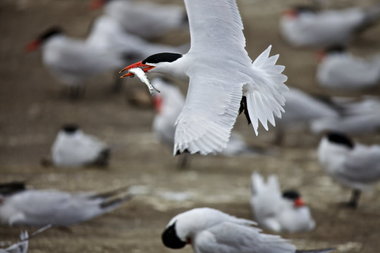Jan. 5: If you're in Cannon Beach Thursday evening, swing by the public library, 131 N. Hemlock St., at 7 p.m. for this month's installment of the World of Haystack Rock lecture series, featuring Katie Voelke, executive director of the North Coast Land Conservancy. Voelke, a biologist, will talk about marine life along the coast.
The series continues the first Thursday of each month. On Feb. 2, Roy Lowe of the U.S. Fish and Wildlife Service will talk about an Oregon connection to the albatross of Midway Atoll National Wildlife Refuge. See the rest of the schedule.
Jan. 10: Biologist Dan Roby will describe the complexities and challenges of managing wildlife on and around East Sand Island in the lower Columbia River, home to the world's largest Caspian tern colony and the biggest colony of double-crested cormorants in western North America, among other species.
The voracious birds, drawn to the 62-acre island created with dredge spoils in the 1980s, eat endangered salmon smolts by the millions each year.
Wildlife managers face the daunting task of trying to protect the birds, while also giving the young fish a chance to make it to sea safe and sound.
The lecture, part of Audubon Society of Portland's Nature Night series, is free, open to the public and begins at 7 p.m. Tuesday in Heron Hall, 5151 N.W. Cornell Road.
Jan. 11: Bull trout, once widely distributed throughout the Willamette River basin, disappeared in the 1960s from the Clackamas River and its tributaries. But a consortium of public agencies, private companies and tribes collaborated to return the fish to the river system, and did so last summer in the upper reaches of the Clackamas.
Biologists Patrick Barry of the Oregon Department of Fish and Wildlife and Chris Allen of the U.S. Fish and Wildlife Service will discuss the project and the prognosis for the species during a 6 p.m. lecture Wednesday in the Ecotrust building's Billy Frank Jr. Conference Center, 721 N.W. Ninth Ave.
Admission to the event, sponsored by the Oregon Wildlife Heritage Foundation, is free but registration is required. Register online. Information: 503-255-6059.
Next up in the Oregon Wildlife Heritage Foundation's lecture series is one Feb. 8 on the state's native turtles; registration for the talk opens Jan. 9.
WOLVES: In the swirl of news about wolves comes confirmation from an Oregon scientist that the predators dramatically alter Yellowstone National Park's ecosystem as their population rebounds, the Associated Press reports this week.
Reporter Matthew Brown writes in the Helena (Mont.) Independent Record, on a study by Oregon State University's William Ripple and Robert Beschta, who for more than a decade have examined the impact of the return of wolf packs to the park on elk populations, and the impact of declining elk populations on aspen groves, willow and cottonwood. As wolves prey on elk and herds thin, vegetation has the chance to return, providing habitat for songbirds and food for beavers, which construct ponds that attract fish, reptiles and amphibians.
The study, already online, is due to be published in the journal Biological Conservation.
WAYWARD WHALE: Last summer, Animal Nature reported on a 40-foot gray whale and calf that went off-course on their northerly migration, swimming up the Klamath River along the California-Oregon border in late June. The calf eventually made its way back to the Pacific, but the mother died on a mid-August morning after stranding in waist-deep water.
Now, with results of a necropsy recently analyzed, scientists know why.
Sarah Wilkin, stranding coordinator with the National Oceanic and Atmospheric Administration stranding coordinator, tells the Times-Standard newspaper of Eureka, Calif., that those weeks in fresh water weakened the mother whale's skin, allowing a deadly fungal infection to enter her system.
No one, however, knows why the animals veered into the river.
- Katy Muldoon; twitter.com/katymuldoon













 Ad Choices
Ad Choices
Comments Feed